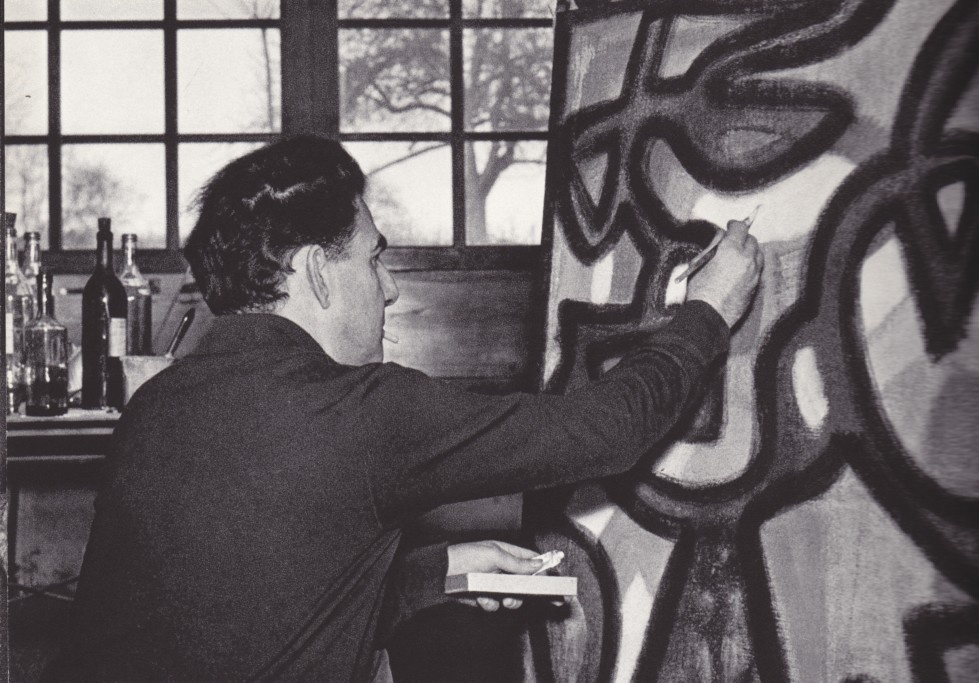Monday from 14am to 7pm
Tuesday to Friday from 11am to 7pm
Saturday from 2pm to 7pm
Alexis Lartigue Fine Art
32 Avenue Matignon 75008
Paris, France
Jean-Michel Atlan

Jean-Michel Atlan, born on January 23, 1913, in Constantine, Algeria, and died on February 12, 1960, in Paris, was a French painter, draftsman, and poet whose work left an indelible mark on 20th-century art.
Coming from a Jewish-Berber bourgeois family from Constantine, Jean-Michel Atlan left Algeria for Paris in 1930. He began studying philosophy at the Sorbonne and became a philosophy teacher, first at the lycée in Laval in 1939, then in 1940-1941 at the lycée Condorcet in Paris. His move with his wife Denise Veron in July 1941 to 16 Rue de La Grande-Chaumière was a turning point for him. In this neighborhood dedicated to painting, his artistic vocation was born.
Atlan began painting in 1941, during the war. His early works were expressionist. Due to his involvement in the Resistance and his Jewish origins, he was arrested in 1942. Atlan pleaded insanity to be interned at Sainte-Anne and remained there until his release in 1944. During his internment, he discovered a world beyond everyday thought and actions, an experience that had a lasting influence on his work.
He published a collection of poems, "Le Sang profond," in 1944 and exhibited for the first time at the Arc-en-Ciel bookstore-gallery on Rue de Sèvres. Despite early successes, he soon lived in poverty, working temporarily as a peddler, fortune teller, and street vendor in the corridors of the Paris metro.
In 1945, he met Gertrude Stein in Paris. She showcased his works in London and New York, opening doors to her collector friends. Jean-Michel Atlan had many admirers and friends, including Hans Hartung, Schneider, Pierre Soulages, and Serge Poliakoff.
From 1945, Atlan created abstract and fantastical figurative animal forms influenced by the high primitivism of the CoBrA group and participated in their exhibitions, though he was not an official member. In 1950, he was invited by the CoBrA magazine to express his views on contemporary art.
From 1953, he enjoyed growing success in Japan, where he had a significant influence on abstract Japanese calligraphy. In 1956, he exhibited at the Bing Gallery, his first solo exhibition in Paris since 1947.
Around 1956, Jean-Michel Atlan's style became more defined. Strong black sinuous lines surrounded fields of pastel tones reminiscent of organic and vegetal associations with themes of combat and the fantastical, stemming from an agnostic and biologist vision of the world. Atlan's artistic breakthrough in 1956 was due to a poster he designed for the "New School of Paris" exhibition at the Charpentier Gallery and an exhibition at the Bing Gallery in Paris.
In the 1950s, Atlan, considered one of the most important representatives of the "New School of Paris," enjoyed significant recognition in France, Japan, England, and the USA. In 1958, he acquired a farmhouse in Villiers-sur-Tholon, Rue des Valots, where he worked in peace.
Jean-Michel Atlan died of cancer in 1960. Many museums in France and abroad acquired his paintings, including the Tate Gallery in London and the National Museum of Modern Art in Paris. A self-taught, unclassifiable artist who came to painting late, neither fully figurative nor entirely abstract, Atlan, through the extreme uniqueness of his art, had a significant influence on the painters around him. His language, close to abstract expressionism, connected him to the CoBrA group. His paintings were severely constructed, with dark, thick, charcoal-like graphics surrounding elementary curved or aggressive forms materialized by vivid colors initially, which gradually softened. Atlan's work delved into the depths of the collective unconscious and the symbolism of magical signs.
In 1963, a retrospective was dedicated to him at the National Museum of Modern Art. He left about 220 works to posterity, including tapestries and illustrations. In 2008, on the occasion of the Atlan donation exhibition, the artist was honored with a room at the National Museum of Modern Art, Centre Georges Pompidou. Concurrently with the Atlan donation exhibition at the Centre Pompidou, the Applicat-Prazan gallery presented an exhibition dedicated to the artist, largely emphasizing works from the end of his life, from 1957 to 1959, with the exception of an important 1948 painting that had a significant influence on the CoBrA group members.